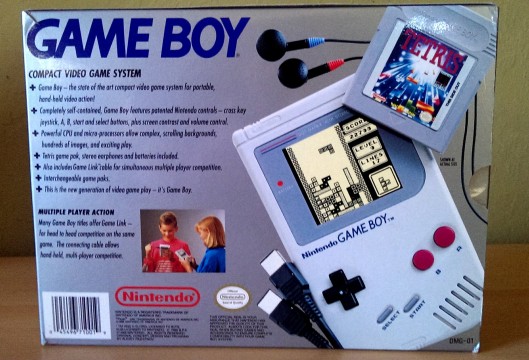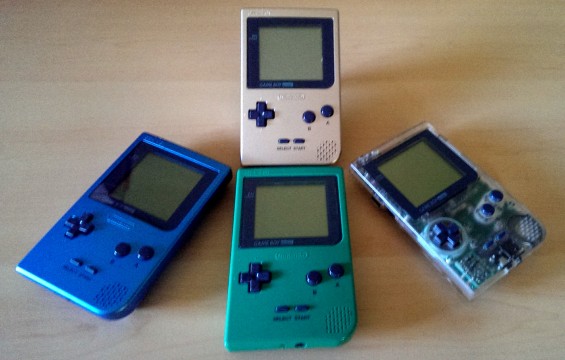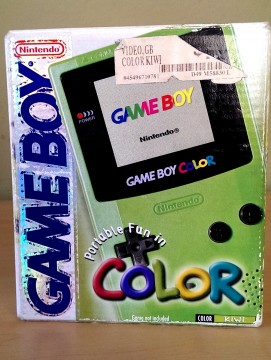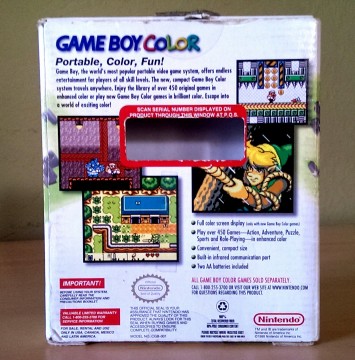
Game Boy

Released: 1989
Here it is, in all its gray, brick-shaped glory: Game Boy. The original version might not look like much now, but it was an amazing piece of technology when it debuted. Game Boy was an 8-bit system with colorless graphics. Employing the same control layout as the NES Control Pad, Game Boy was an intuitive console that was easy to pick up and play. Battery life could clock in around 30-35 hours on four AA batteries, an impressive feat for the era. The system was also one of the first to offer interconnectivity between devices via the Game Link Cable, which would eventually become very important for titles like Pokémon.
This initial design was in production for seven years, though it did see a slight tweak in the form of the Play It Loud! series in 1995, which offered Game Boy in several different colors. One of the more popular of the Play It Loud! “colors” was the highly desirable High Tech Transparent, which featured a clear Game Boy with its innards boldly visible to the world. Between the original and Play It Loud! models of Game Boy, the system would go on to sell over 100 million units.
Fun Facts:
- Game Boy was given the honor of being inducted into the National Toy Hall of Fame in 2009.
- Game Boy was a notoriously hardy system, famous for surviving a multitude of abuses at the hands of its owners (many of these tales were chronicled in the pages of Nintendo Power!). There is perhaps no more famous incident of Game Boy abuse than what happened to one particular unit during the Gulf War. The Game Boy in question was caught in an explosion while its owner and his fellow troops were under attack, which resulted in its outer shell being melted and battered rather grotesquely. Though an unpleasant sight, it was discovered that the Game Boy still worked! It currently resides in the Nintendo World Store in Manhattan. Talk about durable!


Game Boy Pocket

Released: 1996
As reliable and beloved as the original Game Boy was, there was no denying that a redesign was in order. After seven years on the market, Nintendo wasn’t quite ready to move on to a true successor for the hardware, but was aware that the public’s interest in Game Boy was beginning to wane. Enter Game Boy Pocket, the sleeker, smaller, and more efficient descendant of Game Boy! The redesign was an undeniable improvement over the original, and gave the line a shot in the arm that would help keep the ship sailing smoothly for the next few years.
Game Boy Pocket wasn’t just a cosmetic alteration, as it boasted a long battery life using just two AAA batteries (as opposed to Game Boy’s four) and a larger, clearer screen. Though it would quickly be replaced by Game Boy Color just three years later, it played a significant role in informing the look and feel of that new system. Coupled with the introduction of Pokémon in 1998, Game Boy Pocket was an incredibly important stopgap of sorts for Nintendo, keeping the brand alive and vibrant when it needed the boost most.
Fun Facts
- Though the Game Boy line would eventually go on to feature numerous special and limited edition variants, Game Boy Pocket did not-in the west, at least. In Japan, Game Boy Pocket saw a number of interesting special editions, including Hello Kitty, and a version that sported the same color scheme as the original Game Boy. Perhaps one of the quirkiest variants, though, was a clear blue model sold only by Japan’s ANA Airlines (it also featured the airline’s logo!).
- Early models of Game Boy Pocket did not feature a battery life indicator light. The familiar red LED was eventually added after many requests from fans.
- Nintendo debuted a version of Game Boy Pocket with a lit screen called Game Boy Light in 1998, but it never saw release outside of Japan.
Game Boy Color

Released: 1999
Game Boy creator Gunpei Yokoi might have warned against the implementation of colored, backlit screens, but it wasn’t due to an aversion of pigment and light; it was a matter of practicality. Though Game Boy was a huge seller for many years, as time marched forward, fans clamored more and more for Nintendo to release a new Game Boy that utilized both of those features. In 1999, fans got half of their wishes granted when Nintendo released Game Boy Color. The system was very similar in design to Game Boy Pocket, but had more rounded edges and a slightly elongated form by comparison. Running on two AA batteries, Game Boy Color was a vast improvement over its monochrome ancestor, and fans couldn’t get enough of the new device.
Game Boy Color was the first true successor to Game Boy, but that didn’t mean the original handheld was forgotten. In a brilliant move, Game Boy Color was the first backwards compatible portable gaming system; with millions of Game Boys and Game Boy games sold, the inclusion of this feature meant players who bought the system had access to years worth of games to play. What was more, the games could be played in multiple different, simple color palettes (much like what was capable with the Super Game Boy adaptor), which breathed life into a number of old titles. Game Boy Color far outstripped the internal horsepower of Game Boy, with more memory and a faster processor clock speed. Another great addition made for Game Boy Color was an infrared port for wireless communication. Overall, Game Boy Color was a considerable leap over Game Boy.
Fun Facts
- The introduction of Game Boy Color brought with it a number of special edition versions and color schemes. Some particularly noteworthy limited edition Game Boy Colors include several Pokémon variants (emblazoned with various Pokémon and in colors like yellow, orange, and silver), Hello Kitty, and Tommy Hilfiger (not a joke).
- Game Boy Color’s screen could display 56 colors simultaneously and had a palette of 32,768 different hues!


Game Boy Advance

Released: 2001
After 12 years, it finally came time for Nintendo to give Game Boy its biggest overhaul yet. With Game Boy Advance, Nintendo boosted the system’s power to 32-bits and turned the orientation 90 degrees to give it a horizontal, wide control setup. Game Boy Advance also took backward compatibility to the next level, as the handheld played both Game Boy and Game Boy Color games. and players could even adjust the aspect ratio of the screen to their preference. L and R shoulder buttons were added, bringing the system close to the number of inputs on an SNES controller (which wasn’t an accident, as GBA would see numerous ports of SNES games over the years). In general, GBA was a powerful push forward from a technological standpoint.
That’s not to say the handheld was perfect. While fans were satiated with Game Boy Color finally bringing, well, color to a Nintendo portable system, many were disappointed when GBA neglected to bring along a backlit screen. Though games were certainly playable with an external light source, the more color-saturated and detailed graphics of the system made keeping track of the action a little harder than on Game Boy Color. GBA was a bonafide hit regardless, though, and opened the door for floundering genres of video games like 2D platformers.
Fun Facts
- More special editions came for Game Boy Advance, even in the brief span of time that this model was on the market. The special editions included another round of Pokémon variants, though these were generally only sold in Pokémon Centers (and came with familiar faces like Suicune and Celebi), Target, and King of Fighters.
- This is the last Nintendo handheld to have an unlit screen and no rechargeable battery.


Pages: 1 2




 ShareThis
ShareThis







My two fondest memories was playing Mario Land 2 on my Green, Play it Loud Game Boy, and playing the GBASP months before others in California because I imported it. I was the envy of many a Game Boy gamer back then.
It’s amazing to see how far we’ve come. I remember decking my GBA out with every accessory under the sun: screen cover with built in light, rechargeable battery, faceplate with thumbstick, and even a SD card media player. Now they’re all obsolete.
I had my Green Game Boy rocking the Handy Boy accessory with a rechargeable battery pack that allowed the almost portable Game Boy to become a Sega Nomad style cinder block.